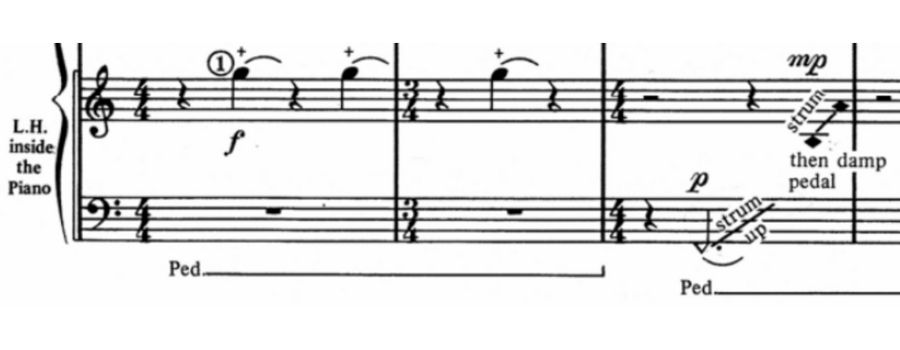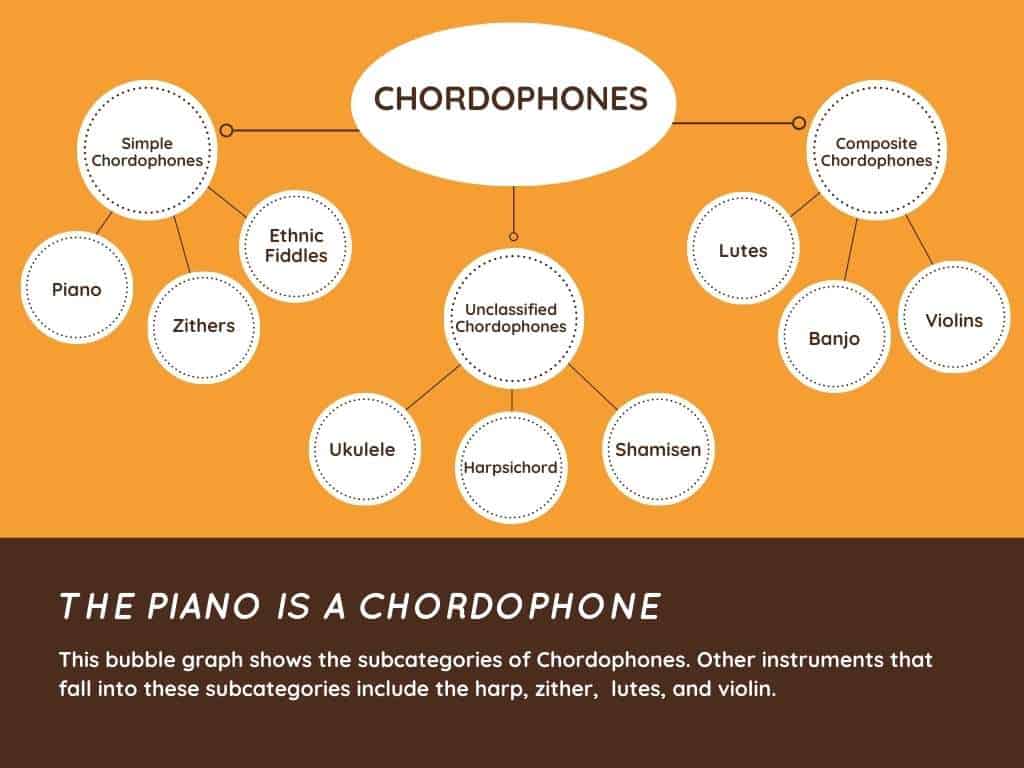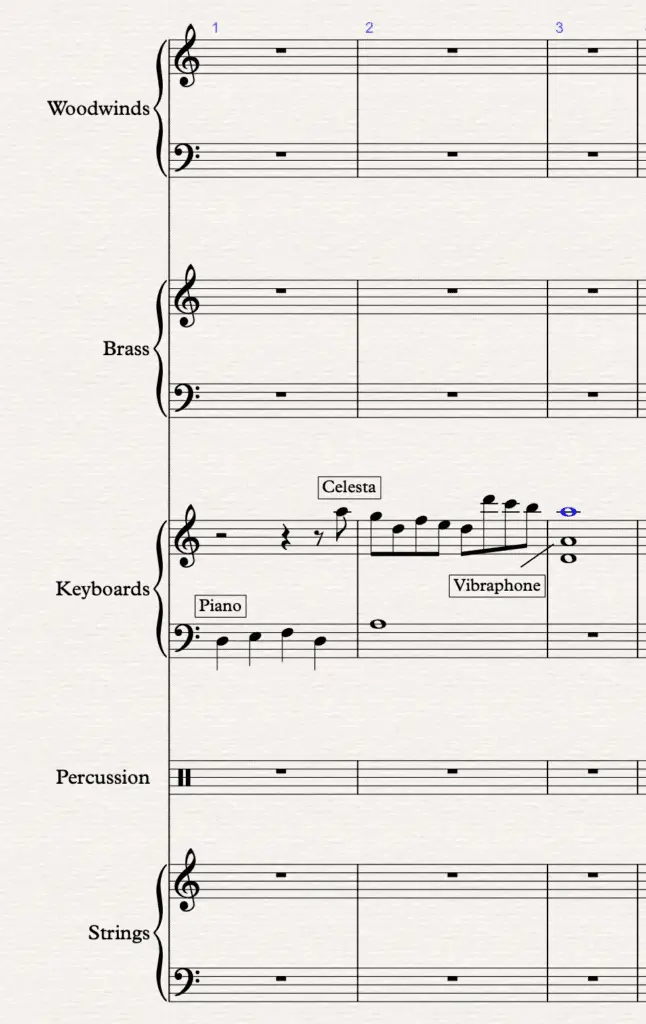
I’m sure a lot of us have played “spot the piano” whenever we’ve walked through a fancy hotel lobby or airport lounge. You hear it tinkering away, growing louder as you approach until you finally spot it, “ahh…there’s that big beautiful string instrument,” you think to yourself.
And assuming it’s a string instrument makes so much sense…it’s a giant box of tightened strings (wires, actually) and it’s those strings that are making the music. Strings or percussion, which category does the piano belong to?
The piano is a percussive chordophone instrument that is played by keys that operate hammers that strike the strings (wires.) It is considered a percussion instrument because it is the hammers that strike the strings, rather than the player directly touching the strings like on a harp.
In a broad sense that does, indeed, make the piano a percussion instrument…but the answer gets a little more complicated.
As music evolves and people come up with new instruments and ways to play them, simply calling the piano a percussion instrument isn’t totally accurate…the piano is starting to encompass more than one category of instruments.
Is The Piano A String Or A Percussion Instrument?
While calling the piano a percussion instrument is still technically…and academically…correct, it is becoming more accepted to consider the piano a string instrument due, in part, to more modern playing techniques such as strumming the strings or plucking them as a violinist will sometimes do…this is where that term “percussive chordophone” comes in.

Percussive Chordophone – An instrument that produces its sound mainly by vibrating strings that are stretched between two fixed points.
-Hornbostel-Sachs
It’s also becoming commonplace for the piano to be referred to simply as “keyboards (or keys,)” and would include instruments such as the celesta, organ, harpsichord, and synthesizers.
When we look at things from an academic viewpoint, we see that there are 4 classifications of instruments:
- Strings (Violin, Viola, Cello, Bass, Harp)
- Aerophones (Woodwind and Brasswind)
- Membrane (Struck Percussion, Snare Drum, Bass Drum, Timpani)
- Body of Instrument (Claves, Cymbals)
People are likely even more familiar with the more common family classification of instruments:
- Strings
- Woodwinds
- Brass
- Percussion
More recent instrumentation and theory books also list a fifth family, Electronic.
And from those families (strings and percussion especially) there are several subfamilies, which is where we move more into the classification grouping of instruments devised by Erich Moritz von Hornbostel and Curt Sachs.

What Category Of Instrument Is The Piano?
As I mentioned above, the piano is a member of the percussive chordophone classification of instruments. Since sound is produced by hammers hitting the piano wires, it most broadly fits in with percussion instruments. However, new playing styles and further study of how the instrument produces its sound is starting to gray the area between percussion and string families allowing the piano to fit into both.
The piano has been classified as a Simple Chordophone by Hornbostel-Sachs (and more specifically a percussive chordophone) which is widely considered the definitive system on instrument classification.
Their system broadened on Victor Charles Mahillon’s work by adding 300 categories to help more accurately classify instruments that didn’t rigidly fit into the main four (strings, aerophone, membrane, body of instrument.)
Digging in deeper and widening the categories also made it easier to classify ethnic instruments such as the Jew’s Harp (aka Jaw Harp) and many African and Asian instruments that would combine percussive elements with stretched, vibrating strings…hey, kind of like the piano!
Studying the Hornbostel-Sachs categorization can get a little confusing since there are so many subcategories and some instruments can fall into different ones depending on how they are played. It’s a fascinating list to study if you want to better understand how various instruments produce their sounds…but, for the purposes of the piano just think of it as a chordophone or even more simply as a percussion instrument.
What Playing Techniques Does A Piano Use?
As I said above, the piano can shift into to other instrument categories depending on how you play it. Here is a small list of the various ways a piano can be played:
- With The Keys
- Strummed
- Plucked
- Bowed
- Prepared
With The Keys – Played “normally” with the player sitting on the bench and pressing the keys which then strike the piano wires, causing them to vibrate and create sound. Played like this the piano is classified as a simple chordophone.
Strummed – The player opens or removes the lid so they can get to the strings. They may press the keys with one hand while running their fingernails or finger pads over the strings or they may use both hands to strum the strings. Playing like this makes the piano an unclassified chordophone.
Plucked – Similar to being strummed, the player will use their fingers or a guitar pick (or other similar tools) to pull on individual strings. The player might still use one hand to press the keys or their feet to operate the foot pedals, creating sustains or gradual releases to the sound. This would make the piano a composite chordophone.
Bowed – The player uses a bow (properly rosined) and pulls it across the strings, just like a violin player. This technique is more difficult to pull off than the others mentioned, mainly due to space between strings and having to angle to bow so it doesn’t hit the frame of the piano. Sometimes this technique is used on a very heavily modified piano. Playing in this style makes the piano a composite chordophone.
Prepared – This is a technique where players will place various objects onto the piano strings or on the hammers of the piano. Doing so will cause various rattle sounds, clunks, shimmers, or any number of other sounds to occur. This doesn’t affect the classification…just the sounds produced since it will still depend on how the player plays the instrument.
How Is The Piano A Percussion Instrument When It Plays The Melody So Often?
Just because an instrument is classified as a percussion instrument doesn’t mean it can’t be melodic…think of the vibraphone, marimba or xylophone, all are percussion instruments and all are melodic instruments.
What those instruments have in common with the piano in regards to instrument classification is that it can shift between melodic and percussive on the fly…or even be a combination of the two at the same time.
In an orchestra, a piano will typically be a melodic (and harmonic) instrument. You’ll often hear it playing a solo melody…like in a piano sonata…or play a flourishing counter-melody while another instrument takes the lead.
But when you listen to a big band (large jazz band) you hear the piano play melodic solos or play a pseudo rhythmic chordal pattern while another instrument is soloing, this is also called comping. The piano will do a combination of the two, playing a melody with one hand while comping with the other. This rhythmic comping is usually riffing off what the drummer is doing, embellishing certain hit points in the measure.
Final Thoughts
Some of you more observational people may have noticed that I put this article under “Strings & Keyboards” rather than “Percussion & Sound Design.” This is because some composers break the instruments down a little differently than the academic ways.

While composers may use the piano in normal ways we tend to think of anything in the broad chordophone class as simply “keyboards.”
This is mainly because composers write, they will often sketch music instead of writing fully orchestrated tunes.
This can also be called “block” composing and will usually consist of 5 or 6 piano staves broken down by section.
The composer will note which instruments they want to play which lines and use this as a guide when they finally get around to orchestrating the piece.
Putting a label on something or making it try to fit into a certain “box” is way too limiting for today’s musicians and composers.
You can go down many deep rabbit holes when studying instrument classification.
Really, unless you’re writing a college paper or are just fascinated by the 300+ classifications of instruments you can get by…and be correct…just classifying the piano as a percussion instrument. If you want to get slightly more accurate then you can call it a chordophone.
